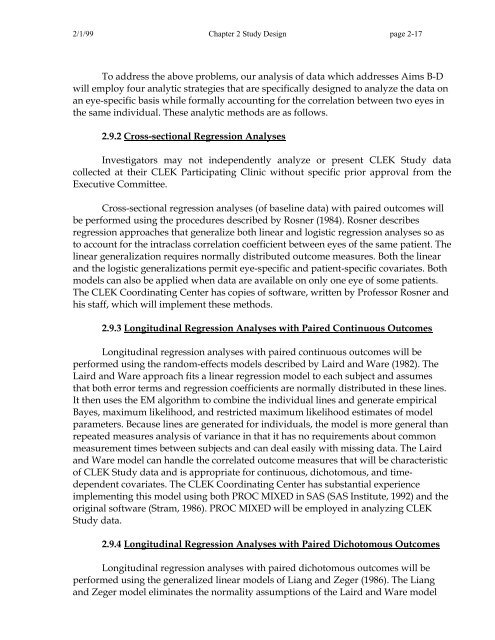OM t of c.iii - Vision Research Coordinating Center - Washington ...
OM t of c.iii - Vision Research Coordinating Center - Washington ...
OM t of c.iii - Vision Research Coordinating Center - Washington ...
Create successful ePaper yourself
Turn your PDF publications into a flip-book with our unique Google optimized e-Paper software.
2/1/99 Chapter 2 Study Design page 2-17<br />
To address the above problems, our analysis <strong>of</strong> data which addresses Aims B-D<br />
will employ four analytic strategies that are specifically designed to analyze the data on<br />
an eye-specific basis while formally accounting for the correlation between two eyes in<br />
the same individual. These analytic methods are as follows.<br />
2.9.2 Cross-sectional Regression Analyses<br />
Investigators may not independently analyze or present CLEK Study data<br />
collected at their CLEK Participating Clinic without specific prior approval from the<br />
Executive Committee.<br />
Cross-sectional regression analyses (<strong>of</strong> baseline data) with paired outcomes will<br />
be performed using the procedures described by Rosner (1984). Rosner describes<br />
regression approaches that generalize both linear and logistic regression analyses so as<br />
to account for the intraclass correlation coefficient between eyes <strong>of</strong> the same patient. The<br />
linear generalization requires normally distributed outcome measures. Both the linear<br />
and the logistic generalizations permit eye-specific and patient-specific covariates. Both<br />
models can also be applied when data are available on only one eye <strong>of</strong> some patients.<br />
The CLEK <strong>Coordinating</strong> <strong>Center</strong> has copies <strong>of</strong> s<strong>of</strong>tware, written by Pr<strong>of</strong>essor Rosner and<br />
his staff, which will implement these methods.<br />
2.9.3 Longitudinal Regression Analyses with Paired Continuous Outcomes<br />
Longitudinal regression analyses with paired continuous outcomes will be<br />
performed using the random-effects models described by Laird and Ware (1982). The<br />
Laird and Ware approach fits a linear regression model to each subject and assumes<br />
that both error terms and regression coefficients are normally distributed in these lines.<br />
It then uses the EM algorithm to combine the individual lines and generate empirical<br />
Bayes, maximum likelihood, and restricted maximum likelihood estimates <strong>of</strong> model<br />
parameters. Because lines are generated for individuals, the model is more general than<br />
repeated measures analysis <strong>of</strong> variance in that it has no requirements about common<br />
measurement times between subjects and can deal easily with missing data. The Laird<br />
and Ware model can handle the correlated outcome measures that will be characteristic<br />
<strong>of</strong> CLEK Study data and is appropriate for continuous, dichotomous, and timedependent<br />
covariates. The CLEK <strong>Coordinating</strong> <strong>Center</strong> has substantial experience<br />
implementing this model using both PROC MIXED in SAS (SAS Institute, 1992) and the<br />
original s<strong>of</strong>tware (Stram, 1986). PROC MIXED will be employed in analyzing CLEK<br />
Study data.<br />
2.9.4 Longitudinal Regression Analyses with Paired Dichotomous Outcomes<br />
Longitudinal regression analyses with paired dichotomous outcomes will be<br />
performed using the generalized linear models <strong>of</strong> Liang and Zeger (1986). The Liang<br />
and Zeger model eliminates the normality assumptions <strong>of</strong> the Laird and Ware model
















